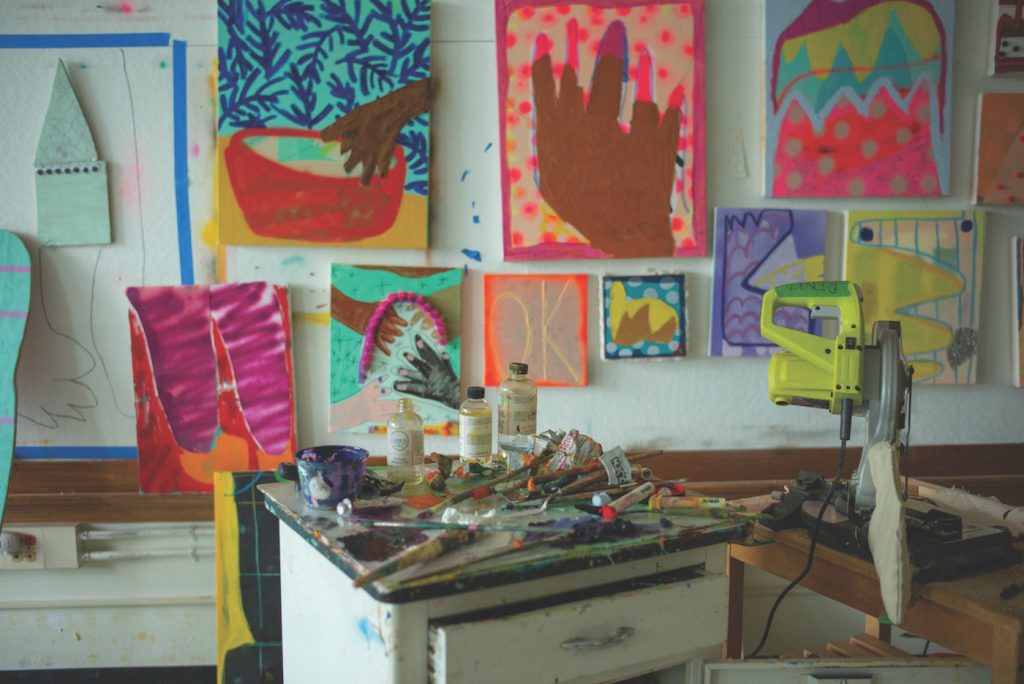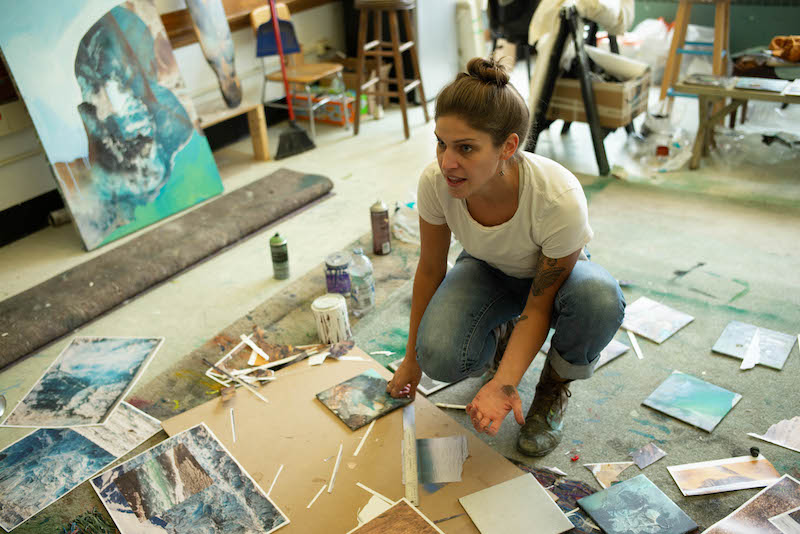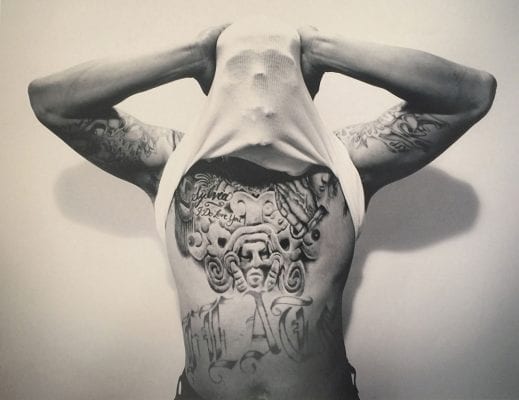Above: Painter Rachel Baxter in her studio at The Church in Troy. Photo by Richard Lovrich
Wandering into the studio of Maria Michails, you’ll find yourself surrounded by books, electronic wiring, mason jars and building material. Scattered about her 8-foot work table are even more wires, bulbs, mini-speakers, wooden blocks and a decorated mechanical rover. Once a church classroom, the workspace has been completely transformed—saved for a remaining whiteboard—to accommodate Michails’ needs. She has built a protruding wall for a mock exhibition space as well as a woodworking station and storage area.
“Come in, come in,” she says. Of course, you’ve already stepped inside, but that’s not what she means. She’s motioning to a small table covered in a patterned cloth and two placemats. She’s putting a saucepan of water on a hot plate for tea and it’s like you’ve stepped out of the workroom into a comfortable living space.
“This has been my home away from home right now,” Michails shrugs, taking a look around the carefully organized clutter of her studio.
The electronic artist and researcher is currently working on an extensive study of air pollution in Albany’s South End where the “bomb trains” sit at the port as well as the community of Canada where the trains start their journey. It’s the culmination of years of work based on data that deeply affects the health and livelihood of each area’s residents. The project has stemmed off in many directions, including air quality monitoring projects with electronic rovers and Native American oral history installations. This summer she’ll be tying it all together in a massive show in Saskatchewan, bringing the two communities together for dialogue over the culmination of her research and the complicated ways their communities connect.

For now, she slathers peanut butter on a thick slice of bread as the pot of water rattles with heat. The work table is cluttered with pieces yet to be arranged and the wall around her drawing station is pinned with notes, sketches and strategies. Behind her is an all-too-inviting rocking chair, full bookshelf and patterned rug. She’s unboxing a fragrant collection of tea and it’s not just comfortable, it’s downright cozy. It is home.
When asked how she discovered and settled into the space, Michails’ answer is not unlike those of her studio neighbors. In fact, the same word seems to bubble up for the artists who create here. “It happened really organically.” Everything at The Church seems to happen in it’s own time, for each individual’s purpose. Even for owner Bob Bedard.
The engineer—and president/CEO of deFacto Global, Inc., an artificial intelligence company—came from Connecticut to be closer to the program developments happening at Rensselaer Polytechnic Institute. He bought the 13th Street building in Troy, formerly Saint Paul the Apostle Church, back in October 2016 in the hopes of kickstarting an event space that could fuse arts, science and technology. In addition to the echoing sanctuary which holds up to 400 people, the church is attached to a school with two floors of spacious classrooms, which artists like Michaels have transformed into the synergetic artist space it is today.
“It was intimidating when I first bought it,” Bedard says. He was still living in Connecticut part-time when he decided to buy St. Paul’s. “I thought, ‘Holy mackerel this place is huge.’ I really didn’t have a sense of what the local market was like because I was still pretty new here … [but] it was for sale and it was amazing … The place came pretty much turn-key. I really didn’t have to do much to it. Coming to Troy, there were a lot of beautiful churches for sale and I hated the idea of churches being cut up and turned into apartments. It’s a cop-out. Churches were designed to bring people together, so let’s keep that theme going.”
Since it opened, The Church’s sanctuary space has hosted artist-organized exhibitions and installations, local maker’s markets, a silent disco and, once, the Troy-famous Polly dance party that Bedard says “rocked the entire neighborhood. The entire church was like a boombox.”
“I’ve offered the church part up to anyone looking to use it, just leave the building standing. That’s all I’m asking,” Bedard laughs. “We’ve pretty much had one of everything. I just kind of put it out there and whatever floats by, we’ll see what happens. That way we’re not forcing anything.”
Bedard’s friend, artist Kate Hamill, was the first to move into the studio space in November 2016. He credits her for pinpointing The Church as the perfect location to serve local artists in need of a creative space to work and play. Rachel Baxter, the second artist to settle here in April of 2017, had reached out to Hamill right away after seeing a photo of her new studio. She posted a photo of her own after moving in. Two weeks later, Bedard says, the place was full.
He recalls that first summer fondly, when the artists worked together to spruce up the place and plan their kickoff party.
“They all came together, painted the place, they really did a lot,” he says. “Sure an artist can say, ‘Well, I can just work from home,’ but the collaborative piece of this is really important.”
There’s something about this building that draws artists in from the very first glance, that inspires them. After just a few years of occupation, it has become a canvas of its own. Remnants of previous art installations still hang in the sanctuary, canvases and chalk drawings line the walls of the hallway and even the windows are decorated with geometric mini paintings of Baxter’s design. The classrooms themselves intoxicate their tenants with so much space to explore and plenty of battling light from the wall of windows and ceiling of fluorescents to play with.

“Typically I try to spend the whole day here,” Baxter grins. The abstract artist teaches printmaking at College of St. Rose in Albany a few days a week and recently dropped her serving job to make more room for her art. You’ll find her at The Church more often than not. “It’s been so beautiful. Every day it feels like a different thing.”
Like Michails, she has made the space her own, covering nearly every corner of the place with her large-scale paintings and collage works. They’re piled against the walls, stacked between ladders. Puzzle-like pieces of canvas are pinned to the walls waiting for the perfect, permanent arrangement.
“This is just so much more open than any other place,” she says, surveying the high ceilings that have accommodated her style so well. “I think just being able to expand outward, the work has grown. I feel like I’m a goldfish sometimes. I’m in a room this big? I’ll make these big paintings. One day I want a warehouse and all my paintings will just be enormous.”
With rent at $550 per room, affordability is a big factor for many of the artists.
“Most people seek the highest return for their investment and I’m not necessarily doing that,” Bedard said. “If I was, I’d be renting it out to students. I think recognizing that the value I’m looking to generate isn’t purely monetary gives me the freedom to do what I want with it.”
Painter Andrew Dines was previously working in the kitchen of the one-room apartment he shares with his wife. He’d had never considered he could afford a real studio space until a former student tipped him off about The Church and he says he is grateful that it provides a change of scenery to inspire his work as well as an opportunity to engage creatively with his peers.
“I find myself thinking about new possibilities from being exposed to what everyone else is doing here,” Dines says. The artist, working mainly in paint and plaster, has been based out of The Church for over a year and a half. He shares a bright room on the second floor with audio-visual artist Adam Tinkle who moved in during the winter of 2018.
“It’s definitely a good community,” he says. “You get something that a lot of us lose after we get out of school, that community of artists all working nearby in a similar space where you can kind of check in on one another.”

It’s certainly helped in the collaboration department. Most recently, collage artist Robert Gullie embarked on a project with photographer Michael Valiquette, his neighbor across the hall.
“It’s a life sport for me. I love to collaborate,” Gullie says excitedly as he gently pushes around patterned oval cut-outs scattered on the floor of a 24-inch “room” sitting on his workshelf. Inside a crouched model figure sits alone, its habitation yet to be decorated. The artist duo, he explains, will make a series of scenes which Valiquette will photograph, then Gullie will collage: A 3D model—flattened, dismantled and rearranged—experiencing an exploration of form.

Despite opportunities to experiment together, the artists are very aware of the precious value of solitary creative time. If a studio door is closed, the artist inside is hard at work.
“I feel like I can be a little braver here because I can shut the door, it’s just me. I don’t feel like there [are] all these eyes on every decision that I make,” Baxter explains. “It’s nice to have that privacy so you can make a really ugly painting and not worry about it. There’s a freedom here that I really like.”
The artists are at liberty to utilize as much of The Church’s potential as they’d like. They organize exhibits and pop-up shows in the sanctuary with artists from out of town and host open studio visits where anyone can come check out their workspace and, maybe, take home a work of art. Bedard says he’ll be investing more of his own time and energy into The Church over the coming years as well. That is, in addition to his new, $2 million technology-based endeavor downtown, the AI Center of Excellence. Bedard believes the planned artificial intelligence research center could draw even more creatives and industry officials to the local area.


“I think of The Church as a cooperative space. Bringing people together with a similar mindset brings a lot of really great energy and opportunities. Cross-pollinating things makes it even more exciting.”
Bedard adds that he’s been dreaming up plans for nearly every inch of the Church property. The basement is already home to the successful local kombucha brewers Yes Folk. He is currently working on turning the church rectory into additional studio space and pursuing a small artist residency program. The two-car garage might make a good welding studio. The grounds outside could serve as a sculpture garden.
“I’ve thought of turning the area into what I’d call a ‘creatrium’ where, during the dreary winter we can simulate a bright, sunny day using lighting [projects] and get artists in there to gather inspiration. There’s so much opportunity here for the intersection of art, science and technology because there are so many people here with those backgrounds and clearly not enough facilities to serve that market,” he says, “I do encourage people to take a look at the space and use their imagination in terms of what they can use it for. Have some fun.”





